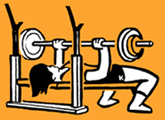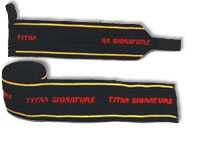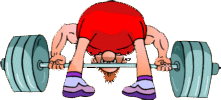|
|
Powerlifting
With this web page, I would like to introduce and
generate interest in the sport of powerlifting. |
|
Powerlifting:
What does it mean?
Powerlifting is a competitive sport of the
strength events and consists of the three disciplines, the
squat (SQ), the benchpress (BP) and the
deadlift (DL). The three exercises are executed in this
order during competitions using a long dumbell.
Currently, powerlifting is not an olympic discipline, as is weightlifting. |
|
|
The three exercises |
 |
To complete the squat,
the practitioner takes the bar from the holdings of the squat
rack, places it behind his neck and lifts his elbows to the back.
The bar is situated on his shoulders without support, only
held by his hands. Then the practitioner take some steps back and
stands with his feet apart. With the weight
on his back, he tightens his stomach, bends his knees and continues
the squat without arching his back until the surface of his
thighs near the hip joint is situated deeper than the top of his
knee. After this he returns back to the starting position,
pushing himself up by means of his heels. |
|
 |
The benchpress is the mostly
wellknown exercise in the fitness centers. The practitioner lies
with his back on the benchpress rack, his shoulders and bottom
in contact with the bench. He pushes his feet against the
floor and makes a backbend. After this, he takes the bar from
the holdings of the benchpress rack, grips the bar and descends
the weight to his chest. When the weight has arrived at its
deepest position on his chest, he stops for a second (!) before
pushing it up again - if possible very quickly - to the starting
position. |
|
 |
The practitioner does the deadlift by placing the
bar horizontally before himself on the floor. He stands in front
of the bar, bends his knees and picks it using a cross grip. After
this, he pulls the weight up, pushing himself up with the chest expanded, stomach tight and without arching his
back by means of his heels and straightens up. His legs are
stable in the end position and his shoulders are pushed back.
There are two different powerlifting methods. The traditional
method (where the hands take the bar outside of the legs) and
the sumo method (where the hands take the bar within the legs).
For this exercise you need a powerful grip.
top |
|
I will explain in detail the benchpress, the most popular exercise of the three.
What do I need for it? |
1, A benchpress rack (if possible a benchpress rack for competition).

|
|
2, An Olympic bar (weight without weights = 20 kg).
 |
3, Various weights
(Weights for competition are colour coded: green =
10 kg, yellow = 15 kg, blue = 20 kg, red = 25 kg,
green = 50
kg; 50 mm in diameter).

|
4, Safety holdings, to prevent the weights from slipping off the bar.
 |
|
5, Sportswear or an one-piece tricot,
a t-shirt for the competition and sport shoes with solid heels
(professionals use bench press shirts)
|
|
6, A weight-lifting belt (it makes sense
to use it, when you lift more than 1 1/2 of the weight of your body)
|
|
7, Tape to protect your wrists.
 |
8, A partner/spotter, who helps you, when you are training with heavy weights.
|
 |
9, And women need above all a solid muscle
power and a lot of paaatience, because nature
favored men with the advantage of power. This is due to the fact that the masculine hormone testosterone is
connected to physical power. Putting power in relation to body weight, as it is done for the competition
score, some of the masculine performances are less
impressive. For example, a man weighting 80kg lifts 80 kg
and a woman weighing 60 kg lifts 60 kg. In this case, both
achieve the same level of performance.
top
|
|
|
|
Rules and competitions |
|
During a competition, the three exercises are
executed in the following series: squat, benchpress and
deadlift. |
|
 |
For each discipline the competitor has three attempts,
only the score of the best is counted. The total of them is the competition
result. The competitors are divided in weight and age classes.
After being weighted, the competitor signals his starting
weight for each discipline. If he is not able to hold it,
regardless which discipline, he is disqualified. The weight
can only be increased, never reduced. For this reason, you must
carefully consider your starting weight and how you
will increase it, so that you will be able to complete all three
attempts, the third attempt being the most painfull. |
|
Each discipline has to be executed according
strict rules. Three referees observe
exactly if the rules are respected, but also a score of 2:1 is valid.
Now I will illustrate the strict
competition regulations using the benchpress as an example: Only after the start
command from the chief referee, may the competitior begin his
lifting attempt. The practitioner takes the bar with a grip that
allows thumb and fingers to surround the bar (training gloves are
not allowed). The width of the grip for the bar is at its
maximum 81 cm. The shoulders and the bottom of the practitioner
have to stay in contact with the bench and his soles in contact with the floor
during the exercise. It is
forbidden that his feet touch the bench. The weight has to be
moved down to his chest and to be held at its deepest position
for a visible break (1 second) without movement. After this, the
bar is pushed up by straightening both arms at the same time.
Once the bar has reached its ending position and the put back
command has been given the bar is put back on the holdings of the benchpress
rack. The required sportswear is an one-piece tricot and a t-shirt.
Competitions for the three disciplines take place on regional and international levels.
Competitions for one discipline, for example the benchpress, are also held.
top |
|
How to learn powerlifting? |
You can train for powerlifting in every fitness center that
has a benchpress, a squat rack and an olympic bar. If you
have never trained in a fitness center, it is necessary above
all that you strenghten your entire body by means of
dumbell and fitness training. For doing powerlifting, it is very important to learn
the correct technique before you start to use a lot of
weight, otherwise you risk injury.
|

top |
|
Why powerlifting?
- Powerlifting makes simply fun!
- Powerlifting gives you a pure power and consequently self-confidence.
- Powerlifting provides relaxation, you will easily forget your daily stress.
- Powerlifting strengthens and
forms your entire body in an ideal manner. Everyone who
has problems with his build no longer needs annoying workout
programs for his stomach, legs and bottom.
- Powerlifting gives you well
defined muscles and it doesn't matter what fashion
magazines sugggest, the well-trained muscular body of a
woman looks very pretty.
- Powerlifting is not dependent
on your age. You can do this sport at every age and take
part in competitions. Powerlifting is even anti-aging,
because it prevents osteoporosis.
- Powerlifting is not annoying like some
fitness training programs, because there is always a
goal - the goal to lift the next weight level.
top |
|
|
|
|
|
Special links: |
| Powerlifting federations and special web pages for powerlifting:
|
Powerlifting clubs:
- Vereinsfinder
(List of powerlifting clubs in Germany)
- www.styrkeloft.no
(Norwegian powerlifting club showing training videos, follow the link: Temasider -> Utdanning)
|
|
Competition rules
(in german):
|
|
Powerlifting equipment:
|
Literature about powerlifting, hints for the
powerlifting training:
- Arndt, Klaus: Synergistisches Muskeltraining
(Synergetical Muscle Training), Novagenics 2001
- Declavier, Frédéric: Muskel Guide (Muscle Guide), blv 2002
- Küster, Rudolf: Trainer/Innen-Unterlagen
KDK (Powerlifting material for trainer), Kassel 1997
- Miessner, Wolfgang: Muskel Guide, Das Trainingsbuch,
(Muscle Guide, Training Book), blv 2004
-
www.novagenics.com
-
www.benchpresschampion.com
-
www.deepsquatter.com/strength/archives/index.htm (training
information)
-
www.nrwpowerlifting.de
|
Anti doping:
-
www.dopinginfo.de
(Information about anti doping of the biochemical institute of Cologne)
top |
|
|
|

